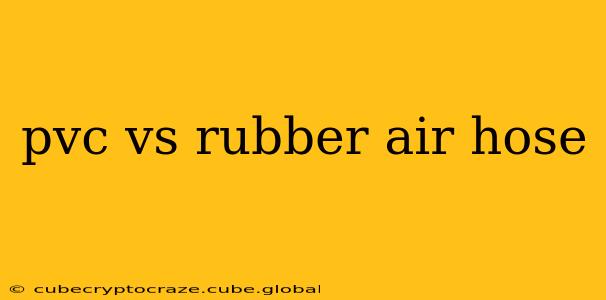Choosing the right air hose can significantly impact your work efficiency and safety. Two popular choices are PVC and rubber air hoses, each with its own strengths and weaknesses. Understanding these differences is crucial for making an informed decision. This comprehensive guide will explore the key distinctions between PVC and rubber air hoses, helping you determine which type best suits your needs.
What are the Differences Between PVC and Rubber Air hoses?
The primary differences between PVC and rubber air hoses lie in their material composition, resulting in variations in flexibility, durability, temperature resistance, and overall cost.
-
Material: PVC (polyvinyl chloride) hoses are made from a synthetic plastic polymer, while rubber hoses utilize natural or synthetic rubber compounds.
-
Flexibility: Generally, PVC hoses are stiffer and less flexible than rubber hoses, especially in colder temperatures. Rubber hoses offer greater flexibility and maneuverability, making them easier to handle and less prone to kinking.
-
Durability: Rubber hoses are typically more durable and resistant to abrasion and punctures than PVC hoses. They can withstand more rough handling and are better suited for demanding applications. However, high-quality PVC hoses can also offer good durability, especially for less strenuous uses.
-
Temperature Resistance: Rubber hoses generally exhibit better temperature resistance, tolerating both higher and lower temperatures compared to PVC hoses. PVC hoses can become brittle in cold weather and may soften or degrade in extreme heat.
-
Cost: PVC hoses are usually less expensive than rubber hoses. This cost difference often reflects the differences in material properties and durability.
-
Weight: Rubber hoses tend to be heavier than PVC hoses of the same length and diameter.
What is a PVC Air Hose Best For?
PVC air hoses are a budget-friendly option suitable for various applications where flexibility and extreme durability aren't critical. They are a good choice for:
- Light-duty applications: Inflating tires, operating small air tools in a controlled environment.
- Indoor use: Their lower flexibility is less of a concern in controlled indoor settings.
- Applications where cost is a primary concern: For occasional use or when budget is limited, a PVC hose is a viable solution.
What is a Rubber Air Hose Best For?
Rubber air hoses are the superior choice when durability, flexibility, and resistance to harsh conditions are paramount. They excel in:
- Heavy-duty applications: Operating powerful air tools, working in demanding environments.
- Outdoor use: Their flexibility and resistance to temperature changes make them ideal for outdoor use.
- Applications requiring superior abrasion and puncture resistance: Construction, industrial settings, and other demanding environments.
- Applications requiring extreme temperature ranges: Rubber hoses can better withstand temperature fluctuations.
Which Type of Air Hose is More Durable?
Rubber air hoses are generally more durable than PVC hoses. Their inherent flexibility and resistance to abrasion and punctures make them better suited for harsh conditions and heavy-duty use. However, the quality of the specific hose significantly impacts durability. A high-quality PVC hose can still provide decent durability for lighter-duty applications.
How Long Do Air Hoses Typically Last?
The lifespan of an air hose depends heavily on its material, usage intensity, and environmental conditions. Proper maintenance, such as avoiding kinks and sharp bends, can extend its life. With proper care, a high-quality rubber hose can last for several years, while a PVC hose may have a shorter lifespan, particularly under demanding conditions.
Are Rubber Air Hoses Worth the Extra Cost?
Whether or not rubber air hoses are worth the extra cost depends on your specific needs and the intended application. For light-duty, occasional use, a PVC hose might suffice. However, for professional applications, heavy-duty use, or demanding environmental conditions, the superior durability and flexibility of a rubber hose justify the higher cost. The investment in a long-lasting, robust hose often translates to cost savings in the long run by preventing frequent replacements.
Conclusion
The choice between PVC and rubber air hoses hinges on your specific requirements. Carefully consider the application, environmental conditions, and desired level of durability to make an informed decision. While PVC offers a budget-friendly option for light-duty applications, rubber hoses provide superior durability, flexibility, and temperature resistance for more demanding tasks. Investing in the right hose ensures optimal performance, safety, and longevity.
